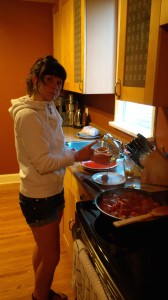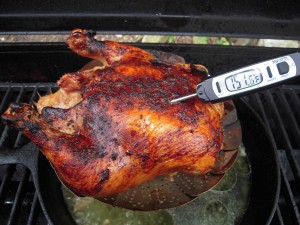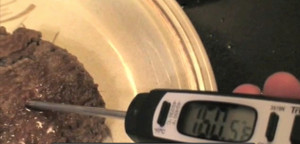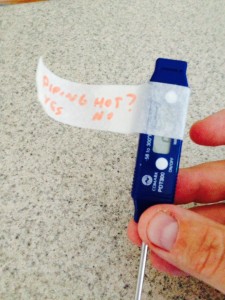Ellen Thomas, a PhD student in food science at North Carolina State University who enjoys running, baking, and playing the violin, writes:
I’ve ordered a crazy number of burgers over the past year. This isn’t because I constantly crave red meat, I’m just interested in what restaurant servers say about eating undercooked burgers.
An E. coli O157:H7 outbreak, which sickened 11 people in 4 different states, has been linked to undercooked burgers at restaurants. Over 1.8 million pounds of ground beef have been recalled.
 The FDA Food Code, adopted in some form by most states, says that it is the duty of the restaurant to disclose risk information around consuming undercooked hamburgers and remind people when they order. Sometimes this is included on the menu, sometimes the servers engage patrons. However, there is no data about whether this actually occurs.
The FDA Food Code, adopted in some form by most states, says that it is the duty of the restaurant to disclose risk information around consuming undercooked hamburgers and remind people when they order. Sometimes this is included on the menu, sometimes the servers engage patrons. However, there is no data about whether this actually occurs.
To capture this data, I’ve trained a legion of secret shoppers to order burgers cooked medium rare, and record the risk information provided on menus and by servers.
It’s been an enlightening process.
A lot of servers talk about color, some talk about temperature, others talk about the firmness of the burger.
There have been numerous situations where a server simply says, “the cook just knows what they’re doing.” A lot of servers assure the secret shoppers that eating a medium rare burger is perfectly safe.
And some responses have been shocking like the server who volunteered, “You’ll be fine eating it medium rare- my sister ate a burger that was raw in the middle when she was pregnant and she was just fine.”
 Unfortunately, misinformation about cooking burgers is widespread. When interviewed by 22News following the E. coli O157:H7 outbreak, Joe Igner, owner of Local Burger in Northampton, Massachusetts, said that he “never had a problem with E. coli” because “it’s recommended to cook ground beef at least 4 minutes and up to 7 minutes on each side.” Nowhere did Igner mention thermometer use. He also stated, “We don’t get it from a processing plant and that’s a big difference because when they process, they process beef and turkey and if they don’t change the blades, that’s when somebody’s going to get sick.”
Unfortunately, misinformation about cooking burgers is widespread. When interviewed by 22News following the E. coli O157:H7 outbreak, Joe Igner, owner of Local Burger in Northampton, Massachusetts, said that he “never had a problem with E. coli” because “it’s recommended to cook ground beef at least 4 minutes and up to 7 minutes on each side.” Nowhere did Igner mention thermometer use. He also stated, “We don’t get it from a processing plant and that’s a big difference because when they process, they process beef and turkey and if they don’t change the blades, that’s when somebody’s going to get sick.”
This is simply not true. Contamination can occur at any point when processing, handling, and preparing raw ground beef, including in a restaurant kitchen, even if it is ground in house.
Sydney Lupkin of ABC writes, So how do you know if your hamburger’s safe? It’s not as simple as you think.
“With ground beef, color is not a reliable indicator of doneness,” said Marianne Graveley, a specialist at the U.S. Department of Agriculture’s meat and poultry hotline.
Meat that’s still pink may be well-done, Graveley said, and meat that’s brown may need more heat.
“We used to have different campaign: It’s done when it’s brown in middle,” she said. “Now we say to use a meat thermometer. It’s the only way to know that it’s safe.”
USDA recommends that hamburgers be cooked to at least 160 degrees internally. But it’s no secret that few of us take the temperature of our patties, and many of us prefer them rare.
“We would never recommend that,” Graveley said. “The risk of food poisoning is too great. People have gotten very sick from very small amount of food. We just don’t think it’s worth the risk.”
 The server response that sticks with me the most is, “I’m just a server- I don’t know what the cooks do.” This may seem like a reasonable statement; servers are usually tending to numerous tables in a very high-paced environment and only pass through the kitchen to pick up dishes.
The server response that sticks with me the most is, “I’m just a server- I don’t know what the cooks do.” This may seem like a reasonable statement; servers are usually tending to numerous tables in a very high-paced environment and only pass through the kitchen to pick up dishes.
When digging into the current outbreak, it’s curious to think whether illnesses have occurred had risks been effectively communicated to consumers. What I’m trying to figure out is how much do servers play a role in advising consumers of their food choices?
Ordering all of these burgers shows me that there are gaps between what happens in a kitchen and what a server tells restaurant patrons. As the server is typically the liaison between the kitchen and the consumer, these gaps mark crucial points where risk information could occur and it is not happening.












